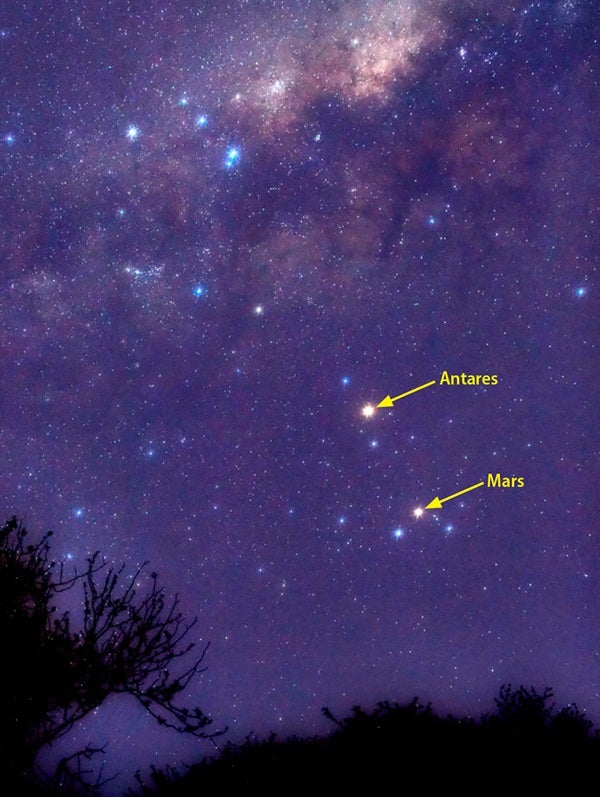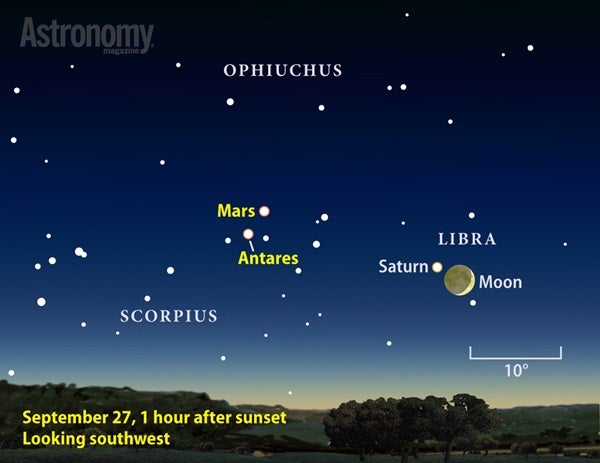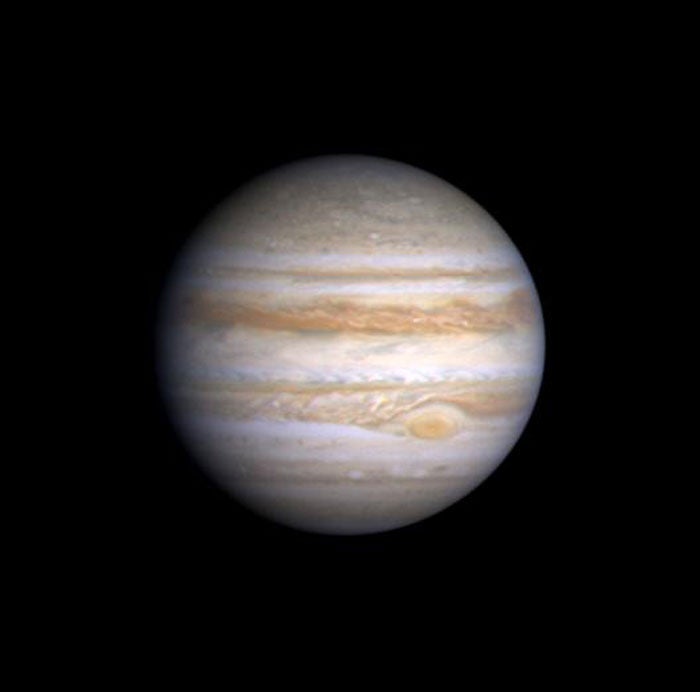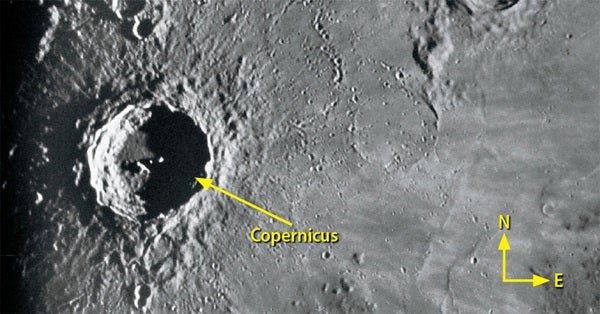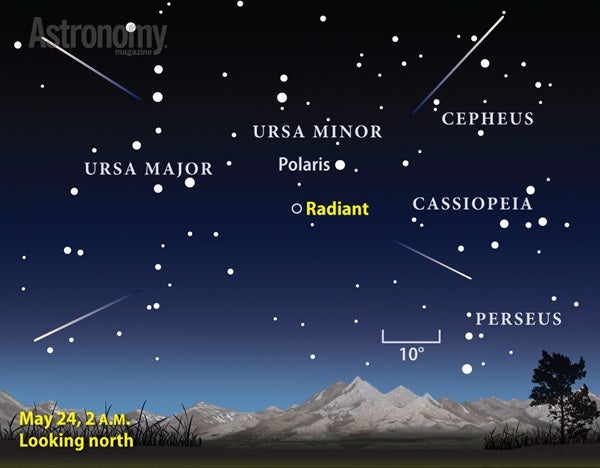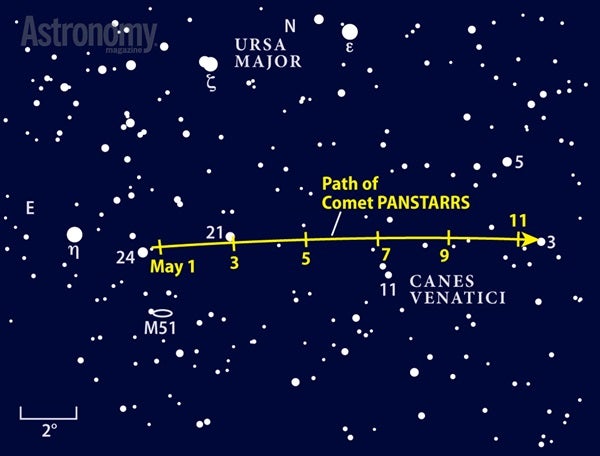Our planetary feast begins low in the west during twilight. Mercury hugs the horizon during most of September for observers at mid-northern latitudes. It reaches greatest elongation from the Sun on the 21st, when it lies 26° east of our star, but it then stands just 3° high a half-hour after sunset. Its altitude remains nearly constant for a week on either side of that date.
Fortunately, Mercury is quite bright. At magnitude 0.0, its light pierces the twilight glow, particularly if you look through binoculars. That optical aid also should reveal 1st-magnitude Spica. Virgo’s brightest star lies 0.6° due north of Mercury on the 20th and remains nearby for a couple of days. A telescope reveals the inner planet’s disk, which spans 7″ and appears slightly more than half-lit at greatest elongation.
A young crescent Moon stands to Mercury’s upper left the evening of September 26, but viewers at mid-northern latitudes will be hard-pressed to spot the planet at this late date. The farther south you live, the better the view. From the Southern Hemisphere, this is the planet’s finest evening appearance of 2014.
Beautiful Saturn lingers above the southwestern horizon as the sky grows dark all month. On September 1, the ringed world stands 20° high an hour after sunset with Mars a scant 5° to its left. Although both planets shine at magnitude 0.6, they may not appear equally bright. Because people perceive colors differently, the ruddy glow of Mars could make it look a bit brighter or fainter than golden-hued Saturn.
The waxing crescent Moon visits Saturn on September 27. At closest approach, less than 1° separates the two objects. For observers in Hawaii, the Moon passes directly in front of the planet during the evening hours. (This event happens in daylight September 28 across western China, western Russia, Korea, and Japan.)
Mars moves eastward relative to the background stars far faster than Saturn, so the gap between the two grows noticeably this month. The Red Planet begins September in Libra, crosses northern Scorpius from the 13th to the 24th, and resides in Ophiuchus during the month’s final days. The planet passes 3°
due north of its ancient rival, the similarly colored 1st-magnitude star Antares in Scorpius the Scorpion, on September 27. A crescent Moon stands directly above the pair two evenings later.
Unfortunately, Mars doesn’t look like much through a telescope. Its diminutive disk measures only 6″ across at midmonth and shows little, if any, detail.
The best-placed objects on this month’s planetary plate are the two ice giants: Neptune and Uranus. Neptune reached opposition and peak visibility in late August and remains a fine target throughout September. By midmonth, it appears some 20° above the southeastern horizon at the end of twilight and climbs highest in the south around midnight local daylight time.
Neptune passes a Full Moon’s diameter (0.5°) north of Sigma on September 11, and it remains near this position for several days. The planet’s slow westward motion keeps it within 41′ of the star throughout September. At magnitude 7.8, Neptune appears brighter than any of the faint suns to Sigma’s north and west. When viewed through a telescope, the planet displays a deep blue-gray color. Switch to high magnification (200x or more) to resolve its 2.4″-diameter disk.
Uranus resides one constellation east of Neptune, floating among the background stars of southern Pisces the Fish, and trails about two hours behind its sibling. Glowing at magnitude 5.7, Uranus is an easy object to find through binoculars and even shows up to naked eyes from under a dark sky. Although Uranus won’t reach opposition until early October, its appearance this month suffers little in comparison.
The major disadvantage for Uranus watchers is that it doesn’t lie close to any bright star. It begins the month 2.6° south-southwest of 4th-magnitude Epsilon (ε) Piscium and drifts along a southwesterly path throughout September. It ends the month 3.5° from this star. Point a telescope at Uranus, and you’ll see its pretty blue-green hue. Its disk spans 3.7″ and shows up at magnifications of 100x or more.
If you find yourself craving some sweets as the night winds down, two tempting planets await. Jupiter climbs above the eastern horizon around 4 a.m. local daylight time in early September, nearly an hour before twilight begins. It then lies 3° east-southeast of the Beehive star cluster (M44) in Cancer the Crab, and the two will make a nice pair through binoculars. By month’s end, the dazzling planet has moved 8° from M44 and rises before 3 a.m. Jupiter shines at magnitude –1.8 (on the 15th) and spices up the rather dim region of sky between Gemini and Leo.
The planet’s quartet of bright moons shows up well through any scope even at low altitudes, however, so you can track them all month. Anyone who has looked at Jupiter more than a couple of times knows that these four change their relative positions each night. After all, Io, Europa, Ganymede, and Callisto orbit the planet with periods of 1.8, 3.6, 7.2, and 16.7 days, respectively, so they rarely repeat the same pattern.
Except, that is, on the mornings of September 6 and 7. Observers in eastern and central North America should target Jupiter just after it rises on the 6th. Ganymede lies west of the planet’s disk and leads the group as it climbs higher in the sky. Io, Europa, and Callisto all appear east of the planet. Look again 24 hours later, and you’ll have a strong feeling of déjà vu. Callisto has moved a bit closer to the planet, but the other moons appear unchanged. How can this be?
Io is set to transit in front of Jupiter on September 6 (an event already underway from the West Coast). One day later, Io has completed a little more than half of an orbit and is just reappearing from behind the planet’s limb. Our line of sight places it in a similar position relative to Jupiter as on the 6th. During the same period, Europa moves out to greatest eastern elongation and then heads back toward the planet, returning to the same spot from our viewpoint. The much slower motions of Ganymede and Callisto keep them in the same relative positions during the 24-hour interval.
Our final nighttime treat rises during twilight shortly after 5 a.m. local daylight time September 1. Venus is an easy object because it shines brilliantly at magnitude –3.9 some 15° to Jupiter’s lower left. When viewed through a telescope, it shows a nearly full disk spanning 10″. On the 5th, the planet passes 0.8° north of 1st-magnitude Regulus in Leo, though you likely will need binoculars to see the star in the brightening sky. Venus slips deeper into the twilight with each passing day and becomes more difficult to spot. By the 30th, it lies less than 7° from the Sun and is lost in our star’s glow.
Earth reaches its autumnal equinox at 10:29 p.m. EDT on September 22. This marks the precise moment when the Sun crosses the celestial equator on its way south. The equinox brings nearly equal amounts of sunlight and darkness across the globe.
A BIG CRATER THAT HAS IT ALL
Terraced walls, complex central peaks, a rough ejecta blanket, and a prominent ray system at Full Moon — it’s no surprise that lunar observers visit Copernicus again and again. The Sun rises over this crater’s tall, modestly sharp rim a couple of nights after First Quarter phase, on the evening of September 4.
The low Sun angle casts long shadows that accentuate the 58-mile-wide crater’s peaks and depressions. Note the jagged black “teeth” projected onto the sandpaper-like floor. A textured apron surrounds Copernicus, the result of ejecta that splattered outward in the aftermath of the crater-forming impact.
The terraced walls are a delight when viewed at high power. Imagine digging a hole in wet sand; within seconds, the steep walls collapse inward to form a giant staircase descending to the floor. Look carefully, and you should notice terraces outside the crater’s wall as well, a result of the rim’s high elevation.
For a few days on either side of the September 8 Full Moon, the nearly overhead Sun beats down on Copernicus. Use your smallest telescope or add a filter to reduce glare, pump up the power, and take in the scenery. The rough terrain and texture differences completely disappear under a high Sun, replaced by a land of light-hued rays and darker mare showing through from underneath. These brightness variations help astronomers piece together the lunar surface’s history. The incoming asteroid that created Copernicus may have landed in a dark lava field, but the blast excavated lighter-hued rocks and hurled them out to form the fantastic ray system.
“Ancient but now disintegrated comets” is how Indiana University astronomer Daniel Kirkwood described the likely origins of meteor showers in 1861. Last year, Comet ISON (C/2012 S1) underlined Kirkwood’s theory when it disintegrated as it passed close to the Sun, releasing an expanding cloud of dusty debris that extended along the inner part of the comet’s orbit. Astronomers now know that every time a periodic comet passes near our star, it also can generate a meteor stream capable of producing a shower.
September’s best meteor shower derives from little-known Comet Kiess (C/1911 N1). It produces the annual Aurigid shower, which typically generates six meteors per hour at its maximum before dawn September 1. Although astronomers aren’t predicting a surge in meteors this year, the numbers do occasionally spike higher. In 2007, for example, observers saw rates up to 130 meteors per hour. With the waxing crescent Moon setting well before midnight, conditions should be ideal for checking out this minor shower in hopes of a major outburst.
| WHEN TO VIEW THE PLANETS |
||
| Evening Sky |
Midnight | Morning Sky |
| Mercury (west) |
Uranus (southeast) |
Venus (east) |
| Mars (southwest) |
Neptune (south) |
Jupiter (east) |
| Saturn (southwest) |
Uranus (southwest) |
|
| Uranus (East) |
|
|
| Neptune (southeast) |
|
|
September features two comets for Northern Hemisphere observers. The first is designated PANSTARRS (C/2012 K1), which should hit 6th magnitude as it climbs into view before dawn during the month’s second half. The comet slithers through Hydra, slightly south of the Serpent’s head. You can find it through binoculars roughly one field east of the open star cluster M48. When viewing through a telescope, a magnification of 100x or more will help you tease out structure.
If you live in the southern United States, you might glimpse 8th-magnitude Comet Siding Spring (C/2013 A1). By late September, Siding Spring has made its way north to southern Scorpius, where it appears low in the southwest after darkness falls from the southern tier of states.
A third comet, Oukaimeden (C/2013 V5), could be a nice subject for observers south of the equator, particularly if it has an outburst and brightens past its predicted 6th-magnitude peak. In early September, it lies in the morning sky on the opposite side of M48 from PANSTARRS. It then races south and east along the body of Hydra. Oukaimeden skims about 1° south of the great spiral galaxy M83 on the 25th.
Asteroid 12 Victoria offers easy pickings for a 6-inch telescope from the suburbs or a 3-incher under rural skies. Although this object reaches opposition September 8, it glows at 9th magnitude all month. You can find it nearly halfway up the southeastern sky in mid-evening near the Great Square of Pegasus.
At the start of September, Victoria lies a stone’s throw from 3rd-magnitude Zeta (ζ) Pegasi. It remains just over
1° from this star during the month’s first week, moving from south-southeast to due south of Zeta. The lack of any similarly bright stars in the area makes it easy to identify the minor planet. If you prefer to see the asteroid shift position from night to night, your best chances come September 10–13 and 19–22. Make a sketch of the stars in the eyepiece, and then compare it to the same field the next night.
English astronomer John Hind discovered this 70-mile-wide space rock September 13, 1850, by noticing its position change relative to the background stars. This technique netted Hind his third asteroid nearly a half-century after Italian astronomer Giuseppe Piazzi spotted the first, Ceres.
Martin Ratcliffe provides planetarium development for Sky-Skan, Inc. from his home in Wichita, Kansas. Meteorologist Alister Ling works for Environment Canada in Edmonton, Alberta.

